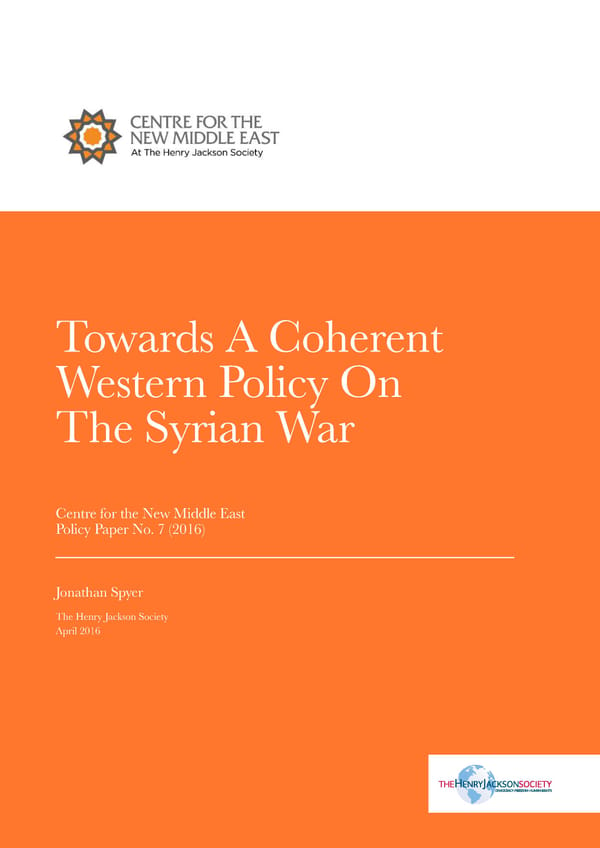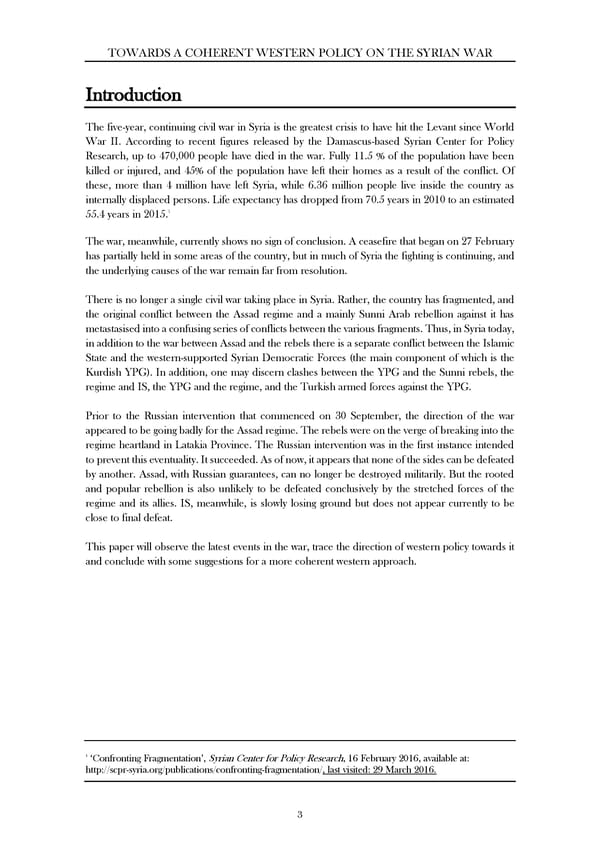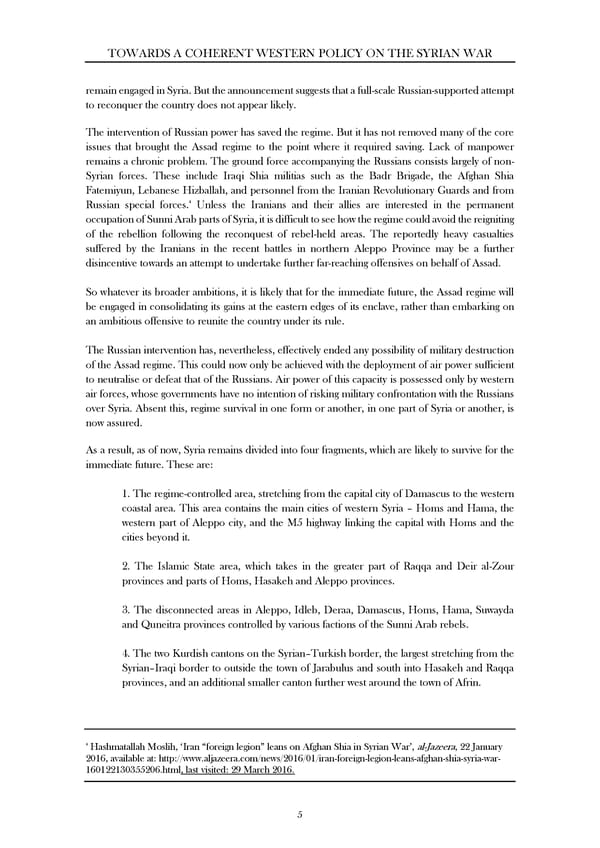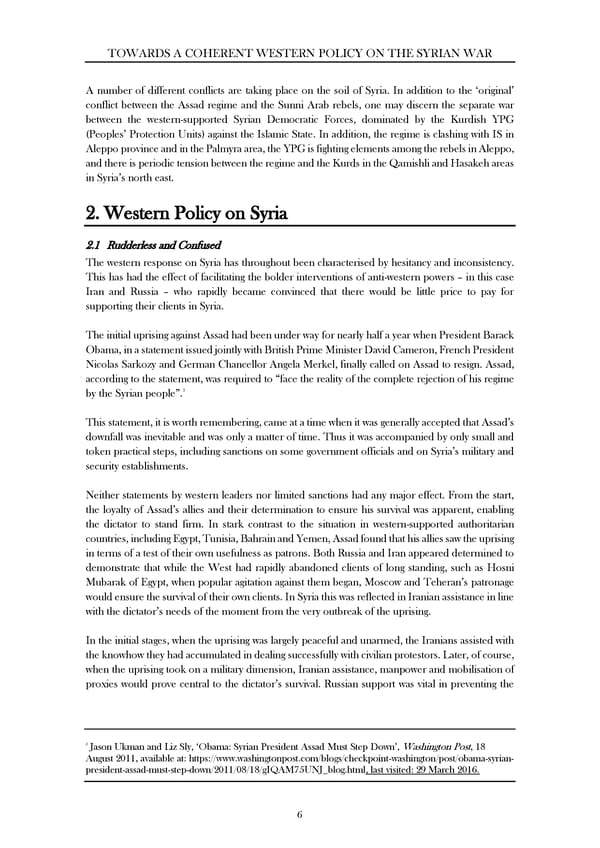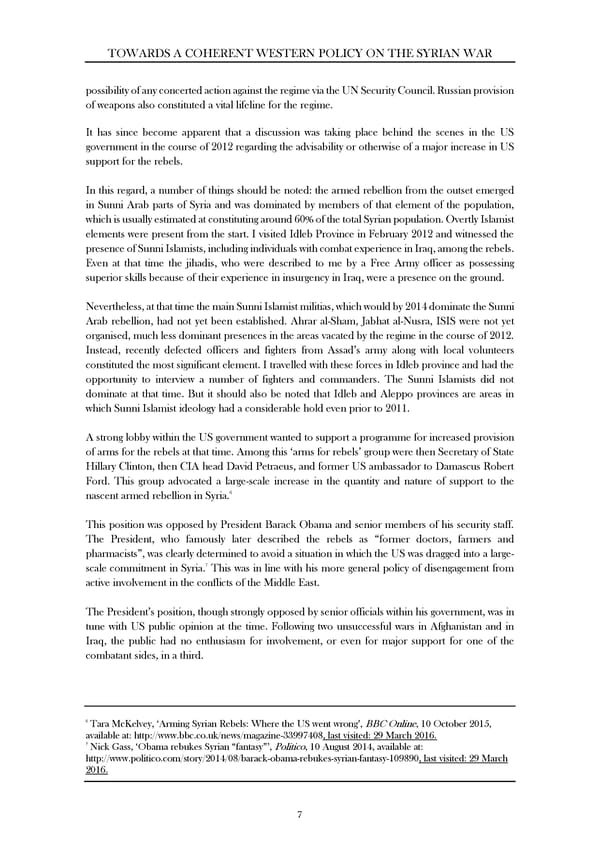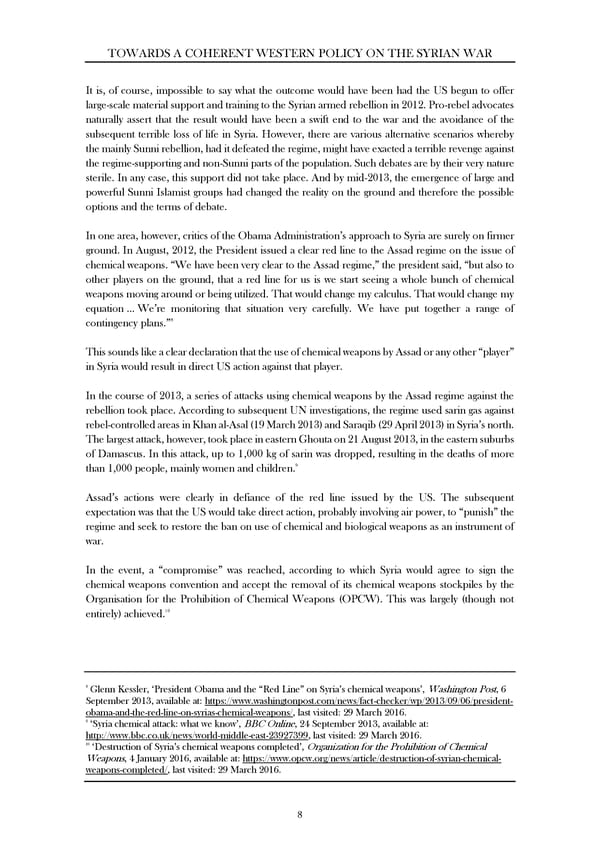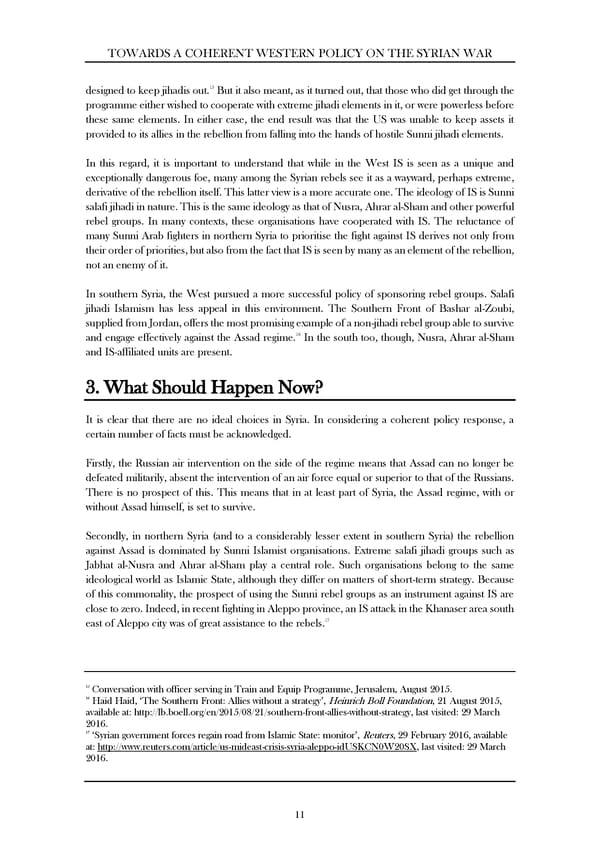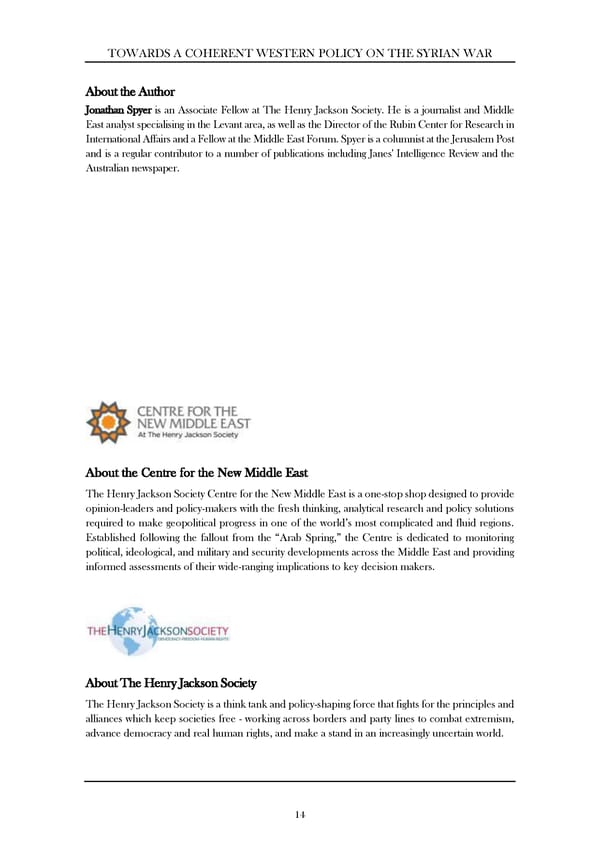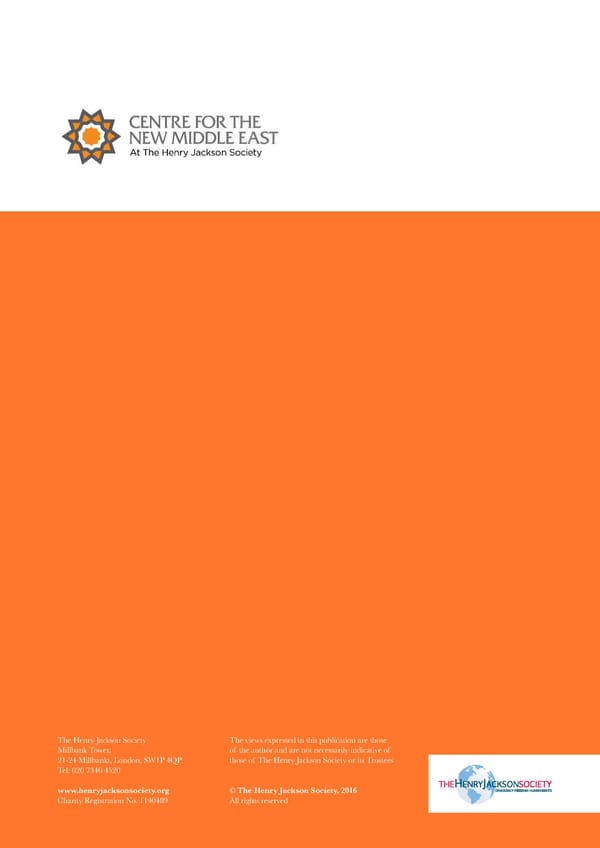Towards A Coherent Policy On The Syrian War
Towards A Coherent Western Policy On The Syrian War Centre for the New Middle East Policy Paper No. 7 (2016) Jonathan Spyer The Henry Jackson Society April 2016
TOWARDS A COHERENT WESTERN POLICY ON THE SYRIAN WAR Summary • Syria today is divided into areas of control. The Russian intervention means that the Assad regime can no longer be defeated militarily, except by a direct western military intervention against Assad, which clearly will not happen. • Western policy on Syria has been characterised by hesitation and by an inability to identify deserving partners. This needs to change. As of now, with Syria de facto divided, the crucial point is to grasp the possibilities inherent in this reality. • The West is currently allied with the Syrian Democratic Forces. This force should be assisted to destroy the Islamic State in the months ahead. Once IS is vanquished, Syria will effectively be divided into an SDF-held east, regime-controlled west, and areas held by the Sunni Arab Islamist military groups. • The subsequent goal should be the establishment of a federal, confederal or partitioned Syria. 2
TOWARDS A COHERENT WESTERN POLICY ON THE SYRIAN WAR Introduction The five-year, continuing civil war in Syria is the greatest crisis to have hit the Levant since World War II. According to recent figures released by the Damascus-based Syrian Center for Policy Research, up to 470,000 people have died in the war. Fully 11.5 % of the population have been killed or injured, and 45% of the population have left their homes as a result of the conflict. Of these, more than 4 million have left Syria, while 6.36 million people live inside the country as internally displaced persons. Life expectancy has dropped from 70.5 years in 2010 to an estimated 55.4 years in 2015.1 The war, meanwhile, currently shows no sign of conclusion. A ceasefire that began on 27 February has partially held in some areas of the country, but in much of Syria the fighting is continuing, and the underlying causes of the war remain far from resolution. There is no longer a single civil war taking place in Syria. Rather, the country has fragmented, and the original conflict between the Assad regime and a mainly Sunni Arab rebellion against it has metastasised into a confusing series of conflicts between the various fragments. Thus, in Syria today, in addition to the war between Assad and the rebels there is a separate conflict between the Islamic State and the western-supported Syrian Democratic Forces (the main component of which is the Kurdish YPG). In addition, one may discern clashes between the YPG and the Sunni rebels, the regime and IS, the YPG and the regime, and the Turkish armed forces against the YPG. Prior to the Russian intervention that commenced on 30 September, the direction of the war appeared to be going badly for the Assad regime. The rebels were on the verge of breaking into the regime heartland in Latakia Province. The Russian intervention was in the first instance intended to prevent this eventuality. It succeeded. As of now, it appears that none of the sides can be defeated by another. Assad, with Russian guarantees, can no longer be destroyed militarily. But the rooted and popular rebellion is also unlikely to be defeated conclusively by the stretched forces of the regime and its allies. IS, meanwhile, is slowly losing ground but does not appear currently to be close to final defeat. This paper will observe the latest events in the war, trace the direction of western policy towards it and conclude with some suggestions for a more coherent western approach. 1 ‘Confronting Fragmentation’, Syrian Center for Policy Research, 16 February 2016, available at: http://scpr-syria.org/publications/confronting-fragmentation/, last visited: 29 March 2016. 3
TOWARDS A COHERENT WESTERN POLICY ON THE SYRIAN WAR 1. Background 1.1 Changing tide, multiple conflicts, de facto fragmentation In early 2015, the tide on the battlefront appeared to be turning decisively against the Assad regime. The main disadvantage facing the regime from the outset was a severe limitation of manpower. This in turn derived from the sectarian nature of the conflict, and the regime’s narrow base of support. Much cogent analysis of the Syrian war predicted that if the mainly Sunni Arab insurgency could avoid destruction, and if it could wholly or partly solve its chronic problems of disunity and fractiousness, then its greater base of support must inevitably, eventually, deliver victory. On 24 March 2015, in north west Syria, a number of powerful Sunni Islamist rebel groups came together to form a new alliance called the Jaysh al-Fatah (Army of Conquest). The alliance included some of the most powerful factions in the area, including Jabhat al-Nusra, the official franchise of al-Qaeda in Syria, and Ahrar al-Sham, the largest and most influential of the Salafi militias in north 2 west Syria. This alliance captured Idleb City on 28 March, and went on to conquer most of Idleb Province in subsequent weeks. At this point, the Assad regime faced a potential existential threat. Its own strategy to deal with its limited manpower since 2012 had been to cede non-essential areas of the country’s north to the rebellion. But now the rebellion stood at the edge of the Sahel al-Ghab, a plain leading into the regime-held Latakia province. Latakia is the heartland of Syria’s Alawite sect, to which the Assad family belongs. It also holds access to Syria’s Mediterranean coast, and contains the Russian naval facilities at Tartus and Latakia city.3 Loss of Latakia would have made inevitable the final defeat of the regime. This possibility triggered the Russian direct intervention that started on 30 September 2015. At one stroke, this intervention changed the course of the war. Russian air power working with the regime, IRGC, Hizballah and other elements has turned the tide once more. The rebels are in retreat in Aleppo province, and the prospect of a complete cutting-off of rebel-controlled eastern Aleppo city is very real. But while the immediate threat to the Assad regime has been neutralised, a general rout of the Sunni Arab rebellion does not appear to be imminent. President Bashar Assad in a recent interview declared his goal to be the complete reconquest of currently divided Syria. But even he acknowledged that this was bound to be a long process. Russia, it now seems clear, is not committed to this process. Indeed, a partial Russian withdrawal of forces has taken place. The Russian intervention was less a strategic masterstroke than a fire-extinguishing exercise intended to avert an imminent threat to the regime’s existence. Russian involvement in the recent reconquest of Palmyra from IS indicates that despite the announcement of withdrawal, Moscow’s forces appear set to 2 Thomas Joscelyn, ‘Jihadist coalition captures checkpoints around city of Idleb’, Long War Journal, 27 March 2015, available at: http://www.longwarjournal.org/archives/2015/03/jihadist-coalition-captures- checkpoints-around-city-of-idlib.php, last visited: 29 March 2016. 3 Mona Alami, ‘Sahl al-Ghab emerges as main focus of Syrian rebels’ fight against regime’, Al-Monitor, 11 August 2015, available at: http://www.al-monitor.com/pulse/originals/2015/08/syria-sahl-ghab-opposition- rebels-regime-assad.html, last visited: 29 March 2016. 4
TOWARDS A COHERENT WESTERN POLICY ON THE SYRIAN WAR remain engaged in Syria. But the announcement suggests that a full-scale Russian-supported attempt to reconquer the country does not appear likely. The intervention of Russian power has saved the regime. But it has not removed many of the core issues that brought the Assad regime to the point where it required saving. Lack of manpower remains a chronic problem. The ground force accompanying the Russians consists largely of non- Syrian forces. These include Iraqi Shia militias such as the Badr Brigade, the Afghan Shia Fatemiyun, Lebanese Hizballah, and personnel from the Iranian Revolutionary Guards and from 4 Russian special forces. Unless the Iranians and their allies are interested in the permanent occupation of Sunni Arab parts of Syria, it is difficult to see how the regime could avoid the reigniting of the rebellion following the reconquest of rebel-held areas. The reportedly heavy casualties suffered by the Iranians in the recent battles in northern Aleppo Province may be a further disincentive towards an attempt to undertake further far-reaching offensives on behalf of Assad. So whatever its broader ambitions, it is likely that for the immediate future, the Assad regime will be engaged in consolidating its gains at the eastern edges of its enclave, rather than embarking on an ambitious offensive to reunite the country under its rule. The Russian intervention has, nevertheless, effectively ended any possibility of military destruction of the Assad regime. This could now only be achieved with the deployment of air power sufficient to neutralise or defeat that of the Russians. Air power of this capacity is possessed only by western air forces, whose governments have no intention of risking military confrontation with the Russians over Syria. Absent this, regime survival in one form or another, in one part of Syria or another, is now assured. As a result, as of now, Syria remains divided into four fragments, which are likely to survive for the immediate future. These are: 1. The regime-controlled area, stretching from the capital city of Damascus to the western coastal area. This area contains the main cities of western Syria – Homs and Hama, the western part of Aleppo city, and the M5 highway linking the capital with Homs and the cities beyond it. 2. The Islamic State area, which takes in the greater part of Raqqa and Deir al-Zour provinces and parts of Homs, Hasakeh and Aleppo provinces. 3. The disconnected areas in Aleppo, Idleb, Deraa, Damascus, Homs, Hama, Suwayda and Quneitra provinces controlled by various factions of the Sunni Arab rebels. 4. The two Kurdish cantons on the Syrian–Turkish border, the largest stretching from the Syrian–Iraqi border to outside the town of Jarabulus and south into Hasakeh and Raqqa provinces, and an additional smaller canton further west around the town of Afrin. 4 Hashmatallah Moslih, ‘Iran “foreign legion” leans on Afghan Shia in Syrian War’, al-Jazeera, 22 January 2016, available at: http://www.aljazeera.com/news/2016/01/iran-foreign-legion-leans-afghan-shia-syria-war- 160122130355206.html, last visited: 29 March 2016. 5
TOWARDS A COHERENT WESTERN POLICY ON THE SYRIAN WAR A number of different conflicts are taking place on the soil of Syria. In addition to the ‘original’ conflict between the Assad regime and the Sunni Arab rebels, one may discern the separate war between the western-supported Syrian Democratic Forces, dominated by the Kurdish YPG (Peoples’ Protection Units) against the Islamic State. In addition, the regime is clashing with IS in Aleppo province and in the Palmyra area, the YPG is fighting elements among the rebels in Aleppo, and there is periodic tension between the regime and the Kurds in the Qamishli and Hasakeh areas in Syria’s north east. 2. Western Policy on Syria 2.1 Rudderless and Confused The western response on Syria has throughout been characterised by hesitancy and inconsistency. This has had the effect of facilitating the bolder interventions of anti-western powers – in this case Iran and Russia – who rapidly became convinced that there would be little price to pay for supporting their clients in Syria. The initial uprising against Assad had been under way for nearly half a year when President Barack Obama, in a statement issued jointly with British Prime Minister David Cameron, French President Nicolas Sarkozy and German Chancellor Angela Merkel, finally called on Assad to resign. Assad, according to the statement, was required to “face the reality of the complete rejection of his regime by the Syrian people”.5 This statement, it is worth remembering, came at a time when it was generally accepted that Assad’s downfall was inevitable and was only a matter of time. Thus it was accompanied by only small and token practical steps, including sanctions on some government officials and on Syria’s military and security establishments. Neither statements by western leaders nor limited sanctions had any major effect. From the start, the loyalty of Assad’s allies and their determination to ensure his survival was apparent, enabling the dictator to stand firm. In stark contrast to the situation in western-supported authoritarian countries, including Egypt, Tunisia, Bahrain and Yemen, Assad found that his allies saw the uprising in terms of a test of their own usefulness as patrons. Both Russia and Iran appeared determined to demonstrate that while the West had rapidly abandoned clients of long standing, such as Hosni Mubarak of Egypt, when popular agitation against them began, Moscow and Teheran’s patronage would ensure the survival of their own clients. In Syria this was reflected in Iranian assistance in line with the dictator’s needs of the moment from the very outbreak of the uprising. In the initial stages, when the uprising was largely peaceful and unarmed, the Iranians assisted with the knowhow they had accumulated in dealing successfully with civilian protestors. Later, of course, when the uprising took on a military dimension, Iranian assistance, manpower and mobilisation of proxies would prove central to the dictator’s survival. Russian support was vital in preventing the 5 Jason Ukman and Liz Sly, ‘Obama: Syrian President Assad Must Step Down’, Washington Post, 18 August 2011, available at: https://www.washingtonpost.com/blogs/checkpoint-washington/post/obama-syrian- president-assad-must-step-down/2011/08/18/gIQAM75UNJ_blog.html, last visited: 29 March 2016. 6
TOWARDS A COHERENT WESTERN POLICY ON THE SYRIAN WAR possibility of any concerted action against the regime via the UN Security Council. Russian provision of weapons also constituted a vital lifeline for the regime. It has since become apparent that a discussion was taking place behind the scenes in the US government in the course of 2012 regarding the advisability or otherwise of a major increase in US support for the rebels. In this regard, a number of things should be noted: the armed rebellion from the outset emerged in Sunni Arab parts of Syria and was dominated by members of that element of the population, which is usually estimated at constituting around 60% of the total Syrian population. Overtly Islamist elements were present from the start. I visited Idleb Province in February 2012 and witnessed the presence of Sunni Islamists, including individuals with combat experience in Iraq, among the rebels. Even at that time the jihadis, who were described to me by a Free Army officer as possessing superior skills because of their experience in insurgency in Iraq, were a presence on the ground. Nevertheless, at that time the main Sunni Islamist militias, which would by 2014 dominate the Sunni Arab rebellion, had not yet been established. Ahrar al-Sham, Jabhat al-Nusra, ISIS were not yet organised, much less dominant presences in the areas vacated by the regime in the course of 2012. Instead, recently defected officers and fighters from Assad’s army along with local volunteers constituted the most significant element. I travelled with these forces in Idleb province and had the opportunity to interview a number of fighters and commanders. The Sunni Islamists did not dominate at that time. But it should also be noted that Idleb and Aleppo provinces are areas in which Sunni Islamist ideology had a considerable hold even prior to 2011. A strong lobby within the US government wanted to support a programme for increased provision of arms for the rebels at that time. Among this ‘arms for rebels’ group were then Secretary of State Hillary Clinton, then CIA head David Petraeus, and former US ambassador to Damascus Robert Ford. This group advocated a large-scale increase in the quantity and nature of support to the 6 nascent armed rebellion in Syria. This position was opposed by President Barack Obama and senior members of his security staff. The President, who famously later described the rebels as “former doctors, farmers and pharmacists”, was clearly determined to avoid a situation in which the US was dragged into a large- scale commitment in Syria.7 This was in line with his more general policy of disengagement from active involvement in the conflicts of the Middle East. The President’s position, though strongly opposed by senior officials within his government, was in tune with US public opinion at the time. Following two unsuccessful wars in Afghanistan and in Iraq, the public had no enthusiasm for involvement, or even for major support for one of the combatant sides, in a third. 6 Tara McKelvey, ‘Arming Syrian Rebels: Where the US went wrong’, BBC Online, 10 October 2015, available at: http://www.bbc.co.uk/news/magazine-33997408, last visited: 29 March 2016. 7 Nick Gass, ‘Obama rebukes Syrian “fantasy”’, Politico, 10 August 2014, available at: http://www.politico.com/story/2014/08/barack-obama-rebukes-syrian-fantasy-109890, last visited: 29 March 2016. 7
TOWARDS A COHERENT WESTERN POLICY ON THE SYRIAN WAR It is, of course, impossible to say what the outcome would have been had the US begun to offer large-scale material support and training to the Syrian armed rebellion in 2012. Pro-rebel advocates naturally assert that the result would have been a swift end to the war and the avoidance of the subsequent terrible loss of life in Syria. However, there are various alternative scenarios whereby the mainly Sunni rebellion, had it defeated the regime, might have exacted a terrible revenge against the regime-supporting and non-Sunni parts of the population. Such debates are by their very nature sterile. In any case, this support did not take place. And by mid-2013, the emergence of large and powerful Sunni Islamist groups had changed the reality on the ground and therefore the possible options and the terms of debate. In one area, however, critics of the Obama Administration’s approach to Syria are surely on firmer ground. In August, 2012, the President issued a clear red line to the Assad regime on the issue of chemical weapons. “We have been very clear to the Assad regime,” the president said, “but also to other players on the ground, that a red line for us is we start seeing a whole bunch of chemical weapons moving around or being utilized. That would change my calculus. That would change my equation … We’re monitoring that situation very carefully. We have put together a range of 8 contingency plans.” This sounds like a clear declaration that the use of chemical weapons by Assad or any other “player” in Syria would result in direct US action against that player. In the course of 2013, a series of attacks using chemical weapons by the Assad regime against the rebellion took place. According to subsequent UN investigations, the regime used sarin gas against rebel-controlled areas in Khan al-Asal (19 March 2013) and Saraqib (29 April 2013) in Syria’s north. The largest attack, however, took place in eastern Ghouta on 21 August 2013, in the eastern suburbs of Damascus. In this attack, up to 1,000 kg of sarin was dropped, resulting in the deaths of more 9 than 1,000 people, mainly women and children. Assad’s actions were clearly in defiance of the red line issued by the US. The subsequent expectation was that the US would take direct action, probably involving air power, to “punish” the regime and seek to restore the ban on use of chemical and biological weapons as an instrument of war. In the event, a “compromise” was reached, according to which Syria would agree to sign the chemical weapons convention and accept the removal of its chemical weapons stockpiles by the Organisation for the Prohibition of Chemical Weapons (OPCW). This was largely (though not 10 entirely) achieved. 8 Glenn Kessler, ‘President Obama and the “Red Line” on Syria’s chemical weapons’, Washington Post, 6 September 2013, available at: https://www.washingtonpost.com/news/fact-checker/wp/2013/09/06/president- obama-and-the-red-line-on-syrias-chemical-weapons/, last visited: 29 March 2016. 9 ‘Syria chemical attack: what we know’, BBC Online, 24 September 2013, available at: http://www.bbc.co.uk/news/world-middle-east-23927399, last visited: 29 March 2016. 10 ‘Destruction of Syria’s chemical weapons completed’, Organization for the Prohibition of Chemical Weapons, 4 January 2016, available at: https://www.opcw.org/news/article/destruction-of-syrian-chemical- weapons-completed/, last visited: 29 March 2016. 8
TOWARDS A COHERENT WESTERN POLICY ON THE SYRIAN WAR However, the lasting effect of the failure of the US to enforce its “red line” was without doubt the growing confidence on the part of the regime and its backers that the will of the US could be ignored with impunity, since the determination of the US to stay out of the war in Syria evidently trumped other considerations concerning deterrence and the maintenance of important international norms. There are those who have sought to draw links between the US decision regarding non-enforcement of the red line on Syrian use of chemical weapons and broader subsequent events, including the Russian decision to invade and annex Crimea in 2014. Such assessments are beyond the scope of this paper. But certainly it should be noted that the use of chemical weapons did not end in 2013. Both the Assad regime and Islamic State have used chemical weapons subsequently, with no apparent penalty. This author was the first to publish the evidence of their use by the Islamic State 11 in the Kobane area, using evidence gleaned during a reporting visit to that region in mid-2014. The Syrian war is the first time that chemical weapons have been systematically used in a conflict in the Middle East since Saddam Hussein’s employment of them against Iraqi Kurds during the ‘Anfal’ operations in 1988. The zigzagging on the issue of chemical weapons use by the Assad regime led to a significant decline in the standing of the US in the region. The subsequent failure of the Train and Equip programme for Syrian rebels, which was intended to create a cohort of US-vetted, US-trained fighters to take on the Islamic State in north east Syria, did nothing to improve this standing. IS emerged as a de facto sovereign entity in northern and eastern Syria in 2014. The organisation proclaimed its holdings in Syria to constitute a new Islamic Caliphate in June 2014.12 It murdered a number of western journalists and aid workers, including two US citizens: James Foley and Steven Sotloff. The murderous nature of ISIS, its capture of Syrian territory, its targeting of westerners and the increasingly Islamist and jihadi nature of the rebellion led to a shifting of focus in 2014/15, away from debate about opposition to Assad and towards the need to challenge IS. The US and western response to the IS threat in Syria took the form of the (now abandoned) Train and Equip programme for vetted rebels in the north, assistance to rebels in the south to defend their areas from IS encroachment, and assistance to the Kurdish YPG organisation in north east Syria, to enable it to both defend and conquer ground captured against IS. Of these efforts, by far the most successful partnering so far in military terms has been between US air power and the YPG, which commenced in October 2014. At that time, the Kurdish canton of Kobani was facing possible disaster. US air intervention enabled the Kurds to turn the tide in the fight against IS. 11 Jonathan Spyer, ‘Did ISIS Use Chemical Weapons Against the Kurds in Kobani?’ Middle East Review of International Affairs, 12 October 2014, available at: http://www.meforum.org/4852/did-isis-use-chemical- weapons-against-the-kurds, last visited: 29 March 2016. 12 Matt Bradley, ‘ISIS Declares New Islamist Caliphate’, Wall Street Journal, 29 June 2014, available at: http://www.wsj.com/articles/isis-declares-new-islamist-caliphate-1404065263, last visited: 29 March 2016. 9
TOWARDS A COHERENT WESTERN POLICY ON THE SYRIAN WAR The YPG alliance, however, had clear advantages for the US beyond the relative military effectiveness of the former’s fighters. I have embedded with YPG fighters on a number of occasions in the Syrian war. The first of these 13 was in early 2013, only a few months after the group’s foundation. The military effectiveness of this group and its greater level of organisation when compared to many of the rebel groupings were apparent from the outset. However, there is also a significant political element which should not be missed. The YPG was a separate entity from the rebellion. The authorities in the autonomous Kurdish cantons regard themselves as following a “third line”, affiliated neither with the regime nor with the rebels. The advantage this afforded the West in partnering with these elements was that the likelihood of weapons or assistance provided to the YPG finding its way to anti-western jihadi elements was zero. The relationship between the Kurdish secular nationalist fighters and the Sunni Arab jihadis was one of animosity. This was in stark contrast to the situation vis-à-vis the rebellion, where the relations between jihadi and non-jihadi or less jihadi elements were and remain ambiguous in the extreme. The domination of the rebellion by Sunni Islamism is the factor which has prevented effective western aid to it. Attempts by the US to identify deserving rebel groups and arm them failed because of the vulnerability of the groups in question before the bigger and stronger Islamist organisations. An example of this may be seen in the fate of the Hazm (Determination) group in northern Syria. This organisation was identified as pro-western and moderate, and was provided in mid-2014 with BGM-71 Tow anti-tank missiles by the United States, in a covert CIA mission. The organisation was challenged and destroyed by Jabhat al-Nusra (al-Qaeda’s franchise in Syria) in October 2014, which then inherited the weaponry in question. Similarly, the larger US-supported Syrian Revolutionaries front, led by Jamal Ma’arouf, was destroyed by Nusra in the same period. The Train and Equip programme received a budget of $500 million from the US government, but only 100 fighters were trained. Of these, 54 entered Syria on 12 July 2015. Despite US air support, within 24 hours the force had been destroyed by Jabhat al-Nusra and its weapons captured. A 14 second group which entered Syria in September suffered a similar fate. The difficulties experienced by the Train and Equip programme derived from two elements: firstly, the US desire to focus on IS undoubtedly clashed with the determination of many rebels to focus their attention on the Assad regime. This may have served to reduce the numbers of recruits to the US-supported training programme. However, a more fundamental difficulty derived from the largely Sunni Islamist nature of the rebellion. This meant that many applicants failed to get through the stringent vetting process 13 Jonathan Spyer, ‘The Kurds are for the Kurds’, The Weekly Standard, 18 March 2013, available at: http://www.weeklystandard.com/the-kurds-are-for-the-kurds/article/706670, last visited: 29 March 2016. 14 Mehmet Cavid Barkcin, ‘First group of FSA soldiers trained by US, Turkey enters Syria’, Daily Sabah, 15 July 2015, available at: http://www.dailysabah.com/politics/2015/07/15/first-group-of-fsa-soldiers-trained-by- us-turkey-enters-syria, last visited: 29 March 2016. 10
TOWARDS A COHERENT WESTERN POLICY ON THE SYRIAN WAR 15 designed to keep jihadis out. But it also meant, as it turned out, that those who did get through the programme either wished to cooperate with extreme jihadi elements in it, or were powerless before these same elements. In either case, the end result was that the US was unable to keep assets it provided to its allies in the rebellion from falling into the hands of hostile Sunni jihadi elements. In this regard, it is important to understand that while in the West IS is seen as a unique and exceptionally dangerous foe, many among the Syrian rebels see it as a wayward, perhaps extreme, derivative of the rebellion itself. This latter view is a more accurate one. The ideology of IS is Sunni salafi jihadi in nature. This is the same ideology as that of Nusra, Ahrar al-Sham and other powerful rebel groups. In many contexts, these organisations have cooperated with IS. The reluctance of many Sunni Arab fighters in northern Syria to prioritise the fight against IS derives not only from their order of priorities, but also from the fact that IS is seen by many as an element of the rebellion, not an enemy of it. In southern Syria, the West pursued a more successful policy of sponsoring rebel groups. Salafi jihadi Islamism has less appeal in this environment. The Southern Front of Bashar al-Zoubi, supplied from Jordan, offers the most promising example of a non-jihadi rebel group able to survive and engage effectively against the Assad regime.16 In the south too, though, Nusra, Ahrar al-Sham and IS-affiliated units are present. 3. What Should Happen Now? It is clear that there are no ideal choices in Syria. In considering a coherent policy response, a certain number of facts must be acknowledged. Firstly, the Russian air intervention on the side of the regime means that Assad can no longer be defeated militarily, absent the intervention of an air force equal or superior to that of the Russians. There is no prospect of this. This means that in at least part of Syria, the Assad regime, with or without Assad himself, is set to survive. Secondly, in northern Syria (and to a considerably lesser extent in southern Syria) the rebellion against Assad is dominated by Sunni Islamist organisations. Extreme salafi jihadi groups such as Jabhat al-Nusra and Ahrar al-Sham play a central role. Such organisations belong to the same ideological world as Islamic State, although they differ on matters of short-term strategy. Because of this commonality, the prospect of using the Sunni rebel groups as an instrument against IS are close to zero. Indeed, in recent fighting in Aleppo province, an IS attack in the Khanaser area south 17 east of Aleppo city was of great assistance to the rebels. 15 Conversation with officer serving in Train and Equip Programme, Jerusalem, August 2015. 16 Haid Haid, ‘The Southern Front: Allies without a strategy’, Heinrich Boll Foundation, 21 August 2015, available at: http://lb.boell.org/en/2015/08/21/southern-front-allies-without-strategy, last visited: 29 March 2016. 17 ‘Syrian government forces regain road from Islamic State: monitor’, Reuters, 29 February 2016, available at: http://www.reuters.com/article/us-mideast-crisis-syria-aleppo-idUSKCN0W20SX, last visited: 29 March 2016. 11
TOWARDS A COHERENT WESTERN POLICY ON THE SYRIAN WAR Nevertheless, it is also the case that even with the Russian intervention, it is unlikely that the rebellion will be completely destroyed. Putin’s announcement of the withdrawal of Russian forces makes such an outcome still less likely.18 The essential problem of lack of sufficient manpower for holding reconquered areas remains for the regime. Thirdly, the most successful western action militarily in the Syrian context to date has been the pairing of western air power with the Kurdish YPG. This has liberated more than 1,000 square kilometres of Syrian territory from IS. The SDF (of which the YPG is the key element) is now located 30km north of the Islamic State’s de facto capital in Raqqa city. Its latest victory against IS, the liberation of the town of Shaddadi, was achieved with a force consisting of 60 percent Kurds and 40 percent Arabs, according to a statement by special US presidential envoy to the coalition 19 against Islamic State, Brett McGurk. It is perhaps worth mentioning that my last visit to Syria, in late December, brought me to the first SDF lines before Shaddadi. I examined the possibility of the upcoming assault on the town in a number of articles. I also conducted extensive interviews with both Kurdish and Arab elements in this force. These included meetings with the Syriac Military Union (a Christian force aligned with the SDF), with Jaysh al-Sanadid (a militia organised by the Shammar tribe) and with the Shams al-Shamal group, which emerged from the non-jihadi rebel groups in northern Syria.20 My impression was of a disciplined and well-organised force. In many visits to Syria in the course of the war, I have ‘embedded’ with a variety of non-government forces, from the Tawhid Brigade in Aleppo at the height of the fighting in August 2012 to the Kurdish YPG. It is my contention that the SDF, and particularly the YPG core of it, represents the most disciplined and organised force that I have encountered. The alliance with the Kurds has proven problematic because of Kurdish determination to unite the Kobani and Jazeera cantons with Afrin further west, and Turkish objection to this. Nevertheless, east of the Euphrates, the SDF continues to advance, gradually cutting off Raqqa city from other holdings of IS. Given all this, coherent western policy regarding Syria should be based on the following lines: Syria is currently effectively partitioned. Since the West does not wish to go to war with Russia to destroy the Assad regime, this fact must be acknowledged. The only effective and reliable ground partner the West has in the fight against IS is the SDF. The war against IS must therefore be prosecuted at a tempo sufficient to ensure the reconquest of IS- controlled areas by the SDF. This would be achieved with US air cover, but a minimal commitment 18 Patrick Wintour and Shaun Walker, ‘Vladimir Putin orders Russian forces to begin withdrawal from Syria’, Guardian, 15 March 2016, available at: http://www.theguardian.com/world/2016/mar/14/vladimir- putin-orders-withdrawal-russian-troops-syria, last visited: 29 March 2016. 19 Robin Wright, ‘Is the Islamic State Hurting? The President’s point man on ISIS speaks out’, New Yorker, 3 March 2016, available at: http://www.newyorker.com/news/news-desk/is-the-islamic-state-hurting-the- presidents-point-man-on-isis-speaks-out, last visited: 29 March 2016. 20 Jonathan Spyer, ‘SDF plays crucial role in Syrian Civil War’, Jane’s Intelligence Review, January 2016,available at: http://www.janes360.com/images/assets/333/57333/SDF_plays_central_role_in_Syrian_civil_war__1_.pdf, last visited: 29 March 2016. 12
TOWARDS A COHERENT WESTERN POLICY ON THE SYRIAN WAR of US forces on the ground. This would ensure that a western-backed force controls this area. It should be made clear to the regime and Russia that no attempt to push into this area will be tolerated. Regime limitations, plus support from regional Sunni states, are likely to prove sufficient to prevent the complete destruction of the mainly Islamist Sunni rebellion in both northern and southern Syria. The provision of assistance to the non-jihadi elements in south west Syria should continue. Political negotiations should be based on the formalisation of the existing division of Syria. Any other approach is bound to facilitate further conflict. The regime and the Sunni rebellion cannot defeat one another. Arrangements for decentralisation, the acknowledgement of the heterogeneous nature of the population of the area and future federal or confederal arrangements offer the only prospect for de-escalating the conflict. Such an approach contains at its root an acknowledgement that Syria as a unitary state based on centralised rule from Damascus has ceased to exist. The country has separated largely along ethnic and sectarian lines. Whether or not this was desirable, denying its reality is certainly counterproductive. The root of coherent policy in both Syria and Iraq lies in understanding the fragmented reality of these countries. Once this is done, potential partners and allies may be identified from among the various ‘successor’ entities currently controlling territory in each of these areas. Conclusion Western policy towards the war in Syria has been characterised by hesitancy born from the determination not to become embroiled in a further Middle Eastern conflict. It has also been characterised by an inability to identify and develop relations with reliable partners. As of now, this has produced a reality in which the Assad regime has assured its survival on part of the country’s territory, while Sunni Islamist, jihadi and Kurdish nationalist elements hold ground in other areas. The West currently has available and reliable assets on the ground in the form of the Syrian Democratic Forces alliance in the north east of the country, and among the Southern Front rebels in the south west. A historic process of fragmentation is under way in Syria and Iraq. It is time to understand the reality and the profound depth and significance of this. Countries created on an artificial basis are in the process of separating out into their component parts. The West cannot afford to remain outside this process. It is therefore of urgent importance that relations with relevant partners be intensified, and that these relationships be used in the bargaining that will follow the conflict. Islamic State must clearly be destroyed. The ambitions of the Iranian/Assad/Hizballah/Russian side must be contained. Sunni Islamism must also be contained. A partitioned or federalised Syria should be the result. These objectives are achievable. Allies and assets exist to further them. Strategic clarity is the first objective from which further gains can follow. 13
TOWARDS A COHERENT WESTERN POLICY ON THE SYRIAN WAR About the Author Jonathan Spyer is an Associate Fellow at The Henry Jackson Society. He is a journalist and Middle East analyst specialising in the Levant area, as well as the Director of the Rubin Center for Research in International Affairs and a Fellow at the Middle East Forum. Spyer is a columnist at the Jerusalem Post and is a regular contributor to a number of publications including Janes' Intelligence Review and the Australian newspaper. About the Centre for the New Middle East The Henry Jackson Society Centre for the New Middle East is a one-stop shop designed to provide opinion-leaders and policy-makers with the fresh thinking, analytical research and policy solutions required to make geopolitical progress in one of the world’s most complicated and fluid regions. Established following the fallout from the “Arab Spring,” the Centre is dedicated to monitoring political, ideological, and military and security developments across the Middle East and providing informed assessments of their wide-ranging implications to key decision makers. About The Henry Jackson Society The Henry Jackson Society is a think tank and policy-shaping force that fights for the principles and alliances which keep societies free - working across borders and party lines to combat extremism, advance democracy and real human rights, and make a stand in an increasingly uncertain world. 14
The Henry Jackson Society The views expressed in this publication are those Millbank Tower, of the author and are not necessarily indicative of 21-24 Millbankt, London, SW1P 4QP those of The Henry Jackson Society or its Trustees Tel: 020 7340 4520 www.henryjacksonsociety.org © The Henry Jackson Society, 2016 Charity Registration No. 1140489 All rights reserved

